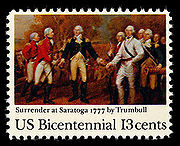
Bicentennial Series
Encyclopedia

It began with the issuance of a stamp showing the logo for the Bicentennial
United States Bicentennial
The United States Bicentennial was a series of celebrations and observances during the mid-1970s that paid tribute to the historical events leading up to the creation of the United States as an independent republic...
celebrations on July 4, 1971, and concluded on September 2, 1983 with a stamp for the Treaty of Paris
Treaty of Paris (1783)
The Treaty of Paris, signed on September 3, 1783, ended the American Revolutionary War between Great Britain on the one hand and the United States of America and its allies on the other. The other combatant nations, France, Spain and the Dutch Republic had separate agreements; for details of...
. While many of the stamps showed the Bicentennial logo as a design element or contained the words "US BICENTENNIAL" or "BICENTENNIAL ERA", not all did.
After the initial issue, few other stamps were issued through 1974. An annual issue of four stamps took place (usually on July 4 of each year): in 1972, honoring Colonial craftsmen; in 1973, Colonial communications; in 1974, the First Continental Congress
First Continental Congress
The First Continental Congress was a convention of delegates from twelve of the thirteen North American colonies that met on September 5, 1774, at Carpenters' Hall in Philadelphia, Pennsylvania, early in the American Revolution. It was called in response to the passage of the Coercive Acts by the...
. In addition, a block of four stamps was issued in 1973 for the bicentennial of the Boston Tea Party
Boston Tea Party
The Boston Tea Party was a direct action by colonists in Boston, a town in the British colony of Massachusetts, against the British government and the monopolistic East India Company that controlled all the tea imported into the colonies...
.
In 1975, with the bicentennial of the start of the [American [Revolutionary War]], the series swung into high gear. Four stamps were issued honoring relatively obscure "Contributors to the Cause", of which the best known was Haym Salomon. On July 4, a block of four stamps was issued showing Revolutionary War uniforms, and with the bicentennial of the Battles of Lexington and Concord, the first of a standardized set began--showing a detail from a painting depicting the event commemorated, with the name of the event and year, and US BICENTENNIAL XX Cents (between 10 and 20). This "painting" format continued with an issue for the Battle of Bunker Hill
Battle of Bunker Hill
The Battle of Bunker Hill took place on June 17, 1775, mostly on and around Breed's Hill, during the Siege of Boston early in the American Revolutionary War...
in June.
On January 1, 1976, a set of three stamps (lacking any text related to the Bicentennial other than the words SPIRIT OF 76) was issued, showing the well-known painting. On February 23, a pane of 50 stamps with the State Flags was issued, each stamp containing the Bicentennial logo and the words "BICENTENNIAL ERA 1776-1976". Four souvenir sheets were issued for the INTERPHIL
INTERPHIL
INTERPHIL, or the Seventh International Philatelic Exhibition, was the seventh decennial philatelic exhibition for the United States held under the auspices of the ...
international stamp exhibition in May, showing famous paintings depicting Revolutionary War events. It was followed with a Bicentennial stamp honoring Benjamin Franklin.

United States Postal Service
The United States Postal Service is an independent agency of the United States government responsible for providing postal service in the United States...
had planned to issue another 50-stamp pane, showing the entire Declaration of Independence
United States Declaration of Independence
The Declaration of Independence was a statement adopted by the Continental Congress on July 4, 1776, which announced that the thirteen American colonies then at war with Great Britain regarded themselves as independent states, and no longer a part of the British Empire. John Adams put forth a...
. Plans were shelved after the American Philatelic Society
American Philatelic Society
The American Philatelic Society is the largest nonprofit stamp collecting and organization of philately in the world, with almost 44,000 members from 110 countries...
threatened the USPS with a "black blot" for excessive stamp issuance. Instead, a strip of four stamps showing part of the John Trumbull
John Trumbull
John Trumbull was an American artist during the period of the American Revolutionary War and was notable for his historical paintings...
painting showing the presentation of the Declaration (often believed to show its signing) was issued on July 4 (parts of Trumbull paintings were used for the issues for Bunker Hill and Saratoga, as well).
A painting-format stamp was issued January 3, 1977 for Washington's successful battle at Princeton.http://www.papercatalogsonline.com/dev/mysticstamp/2006/lg_display.cfm?page_number=55&catalog=MS Similarly painting stamps were issued to commemorate the Battle of Oriskany
Battle of Oriskany
The Battle of Oriskany, fought on August 6, 1777, was one of the bloodiest battles in the North American theater of the American Revolutionary War and a significant engagement of the Saratoga campaign...
and the Battle of Saratoga
Battle of Saratoga
The Battles of Saratoga conclusively decided the fate of British General John Burgoyne's army in the American War of Independence and are generally regarded as a turning point in the war. The battles were fought eighteen days apart on the same ground, south of Saratoga, New York...
. Four stamps were issued on July 4 to honor craftsmen with the legend "Skilled Hands for Independence". Additional stamps honored the Articles of Confederation
Articles of Confederation
The Articles of Confederation, formally the Articles of Confederation and Perpetual Union, was an agreement among the 13 founding states that legally established the United States of America as a confederation of sovereign states and served as its first constitution...
and the arrival of Lafayette. One of the Christmas stamps that year, though not formally part of the series, showed Washington kneeling at Valley Forge.
By 1978, not only was the nation losing interest in the Bicentennial, but most of the events familiar to citizens from school history books had already had their bicentennials pass. Only a single stamp, noting the French Alliance, was issued. The next stamp issue would not occur until 1981, when two stamps marked the Battle of Yorktown
Siege of Yorktown
The Siege of Yorktown, Battle of Yorktown, or Surrender of Yorktown in 1781 was a decisive victory by a combined assault of American forces led by General George Washington and French forces led by the Comte de Rochambeau over a British Army commanded by Lieutenant General Lord Cornwallis...
. The final stamp in the series, noting the Treaty of Paris in the painting format, was issued in 1983.
A number of items of postal stationary were issued. Notably, the USPS found issuance of postal stationary a convenient way of marking the bicentennial of some of the more obscure, but important battles of the war (such as 1781's Battle of Cowpens
Battle of Cowpens
The Battle of Cowpens was a decisive victory by Patriot Revolutionary forces under Brigadier General Daniel Morgan, in the Southern campaign of the American Revolutionary War...
) without the need to issue a stamp. Instead, a postal card
Postal card
Postal cards are postal stationery with an imprinted stamp or indicium signifying the prepayment of postage. They are sold by postal authorities. In January, 1869 Emanuel Herrmann of Austria described the advantages of a Correspondenz Karte. By October, 1869 the world's first postal card was...
was issued.
A number of other issues, while not part of the series themselves, had Bicentennial themes. The standard definitive postal card, throughout the Bicentennial Era, honored figures of that time such as John Hancock
John Hancock
John Hancock was a merchant, statesman, and prominent Patriot of the American Revolution. He served as president of the Second Continental Congress and was the first and third Governor of the Commonwealth of Massachusetts...
and Charles Thomson
Charles Thomson
Charles Thomson was a Patriot leader in Philadelphia during the American Revolution and the secretary of the Continental Congress throughout its existence.-Biography:...
. The 7.7 cent coil stamp
Coil stamp
A coil stamp is a type of postage stamp sold in strips one stamp wide. The name derives from the usual handling of long strips, which is to coil them into rolls, in a manner reminiscent of adhesive tape rolls...
for bulk rate issued in 1976 contains the inscription "Beat the Drum for Liberty and the Spirit of 76" (it depicts a drum). Envelopes, cards, and aerogrammes all had Bicentennial themes.

